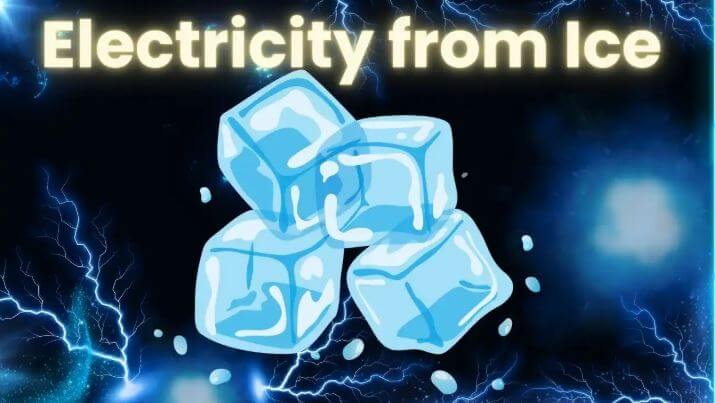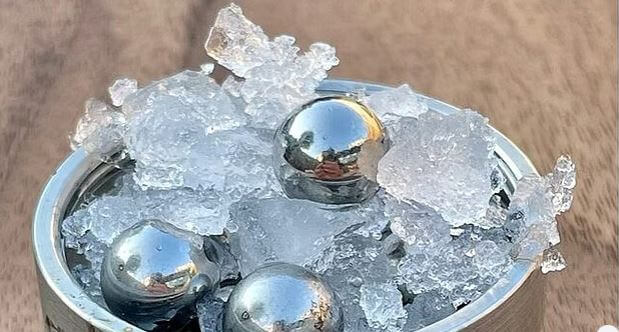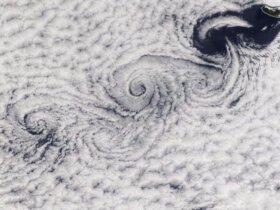Introduction: Breaking Conventional Wisdom and Opening New Vistas
Electricity from Ice: Water freezing into ice is a common natural phenomenon. In our daily lives, ice represents coolness, stability, and inertness. According to basic physics, ice is a very poor electrical conductor or nearly an insulator, which obstructs the flow of electricity. This conventional view is primarily based on ice’s static electrical properties, particularly its ability to allow charges to move through it. However, recent international scientific research has taken this concept in a new direction. Scientists have discovered that ice is not just limited to spreading its coldness; it can also generate electricity under specific conditions.
These new research findings have uncovered a completely different aspect of ice. They prove that the limitations of our conventional knowledge in understanding ice’s electrical behavior are not just a simple factual error, but a lack of a deeper scientific understanding. We have long considered ice’s insulating capacity its only electrical measure. However, the new studies shed light on ice’s dynamic and mechanical stress-induced charges, highlighting a fundamental difference between static and dynamic charges.
This is an important nuance that helps clear up a long-standing misconception for the general reader and shows that a substance cannot be defined by just one property. Its different properties can be revealed based on the environment, temperature, and situation. This unexpected discovery is not just a matter of scientific curiosity; it also offers a new avenue for solving the mystery of lightning formation and developing future eco-friendly technologies.
The Science of Invisible Energy: Flexoelectricity and the Triboelectric Effect

The scientific basis for generating electricity from ice is founded on two principles of physics: flexoelectricity and the triboelectric effect. Both methods convert mechanical stress or motion into electrical energy, but their mechanisms are entirely different.
When Ice is Bent: The Surprise of Flexoelectricity
Typically, materials like quartz or specific types of ceramics generate electricity when mechanical pressure is applied. This phenomenon is called piezoelectricity. But ice is not piezoelectric. In its common hexagonal crystal structure, the polarity of its molecules is arranged so that no overall electrical charge is produced, even when uniform pressure is applied. For many years, this puzzled scientists because while ice plays a significant role in lightning formation, the specific process of its electricity generation remained unclear.
A groundbreaking solution to this problem came from a team of researchers at the Catalan Institute of Nanoscience and Nanotechnology (ICN2) and Stony Brook University. Their study, published in Nature Physics, showed that ice can generate electricity when bent or twisted. This phenomenon is known as flexoelectricity. It is a principle where electric polarization and non-uniform strain are coupled within an insulating material. The researchers created a slab of ice, placed it between metal plates, and bent it in a controlled way while monitoring the voltage. The results showed that the electrical signal corresponded to the degree of curvature of the ice, which is exactly what flexoelectricity predicts. One of the lead researchers, Dr. Xin Wen, commented, “We discovered that ice generates electric charge in response to mechanical stress at all temperatures”. This discovery places ice on par with advanced electroceramic materials like titanium dioxide and strontium titanate.
The most significant impact of this discovery is the solution to the long-standing mystery of lightning formation. Scientists know lightning is caused by the separation of charges resulting from collisions between ice particles and soft hailstones called graupel within clouds. Until now, the specific mechanism of these collisions was unclear. Flexoelectricity removes this ambiguity. When particles in the clouds collide, they don’t just experience uniform pressure, but also non-uniform bending or twisting stresses. This non-uniform stress separates the charges through the flexoelectric effect. This discovery links laboratory findings with the dynamics of real clouds, adding a new line of thought to meteorology.
The Birth of Electricity from Friction: Triboelectric Nanogenerators (TENG)
The triboelectric effect is the second method of generating electricity from ice. It produces electricity through friction or contact between two different materials. Using this principle, scientists are developing Triboelectric Nanogenerators (TENG) specifically designed to harvest energy in cold and snowy environments. The snow-based TENG (snow-TENG) is created using a single electrode and generates electricity through friction during snowfall or when walking on an icy surface.
These prototypes have shown excellent performance. One study found that a single-electrode snow-based TENG can generate an instantaneous output power density of up to 0.2 mW per square meter, an open circuit voltage of up to 8V, and a current density of up to 40 µA per square meter. Since the friction between ice and other materials is very low, these devices experience minimal wear and tear, which extends their operational life. Additionally, due to the rapid phase change of ice, the device shows a “self-healing” property, which helps it maintain its original performance even after being damaged. This technology creates possibilities for a wide range of applications, from wearable devices to sensors in remote areas.
Although TENG’s power generation capacity is lower than that of conventional generators, its significance lies entirely in a different area. It is not a replacement for traditional energy, but rather a distributed energy source suitable for small, mobile devices or sensors. It can supply power in places where large grids are not accessible, solving the ‘last mile’ problem of energy. Its design is highly flexible and low-cost to manufacture. It has a high efficiency in converting mechanical energy to electricity, especially at low frequencies. This proves that TENG is more suitable for creating small-scale devices than conventional renewable energy sources.
Technology and Applications: The Versatile Use of Ice

The principles of generating electricity from ice are not just scientific curiosities but also open new paths to solving various real-world problems. This technology, in particular, creates new possibilities in cold and extreme environments.
Cool Technology for Cold Weather: Ice-Based Nanodevices
Ice-based technologies could revolutionize power generation, especially in remote areas like polar regions or high altitudes, where conventional sources are ineffective. These technologies can autonomously collect energy and reduce the need for batteries or wired connections.
- Wearable Devices and Sensors: Using snow-based TENGs, it is possible to create wearable devices that harvest energy from human movements like walking, running, or jumping. These devices could also be used as biomechanical sensors for winter sports, monitoring physical activity. Their flexibility and lightweight nature make them comfortable and practical to wear.
- Ice Detection on Aircraft: Ice accumulation on the surface of an aircraft or drone is a major safety risk. TENGs can be an effective solution to this problem. When these nanogenerators are placed on the surface of an aircraft or drone, they can provide real-time signals of ice buildup or the friction generated during de-icing. This can automatically initiate the de-icing process, which reduces the risk of accidents. A prototype ice sensor was successfully tested on a flying drone, where it detected both icing and de-icing and demonstrated a high signal-to-noise ratio.
- Automated Weather Stations: Snow-based TENGs can act as automated and self-powered weather stations. They can measure the snowfall rate, depth, wind direction, and speed. When these compact sensors are installed in polar or remote mountainous regions, they can reduce dependence on conventional weather stations and eliminate the hassle of battery replacement.
“Ice Batteries” for Power Storage: A New Horizon for Grid Stability
Even though ice does not directly produce electricity, it can store energy and help reduce the strain on the power grid. This method is called an “Ice Battery” or thermal energy storage. In this system, water is frozen into ice at night when electricity demand is low and prices are cheap. During the day, when electricity demand is at its peak, this stored ice cools buildings instead of running air conditioners.
This method is not about producing electricity, but rather a new strategy for electricity management. It can also be considered a ‘load shifting’ strategy, which reduces strain on the grid and helps balance it with renewable energy sources (like solar and wind). This technology is particularly effective in places with solar panels, as it reduces the reliance on the grid to meet AC demands during peak sunlight hours. Dr. Patrick Shamberger of Texas A&M University states that building more power plants is a costly solution to grid problems. Instead, ice-based energy storage makes the grid more stable and resilient. Ice Energy’s company claims that this technology can save customers up to $1,200 annually on their electricity bills. This proves how small-scale, local solutions can contribute to solving a larger infrastructural problem.
Comparison with Other Energy Sources: Can Ice Compete?
Can ice-based technology be an alternative to conventional renewable energy? No, instead, it will complement other renewable energy sources.
Comparison of Ice-Based Technology with Solar Power
Solar panels show maximum efficiency in daylight, but their effectiveness decreases significantly when covered in ice or snow. While cold weather can increase the efficiency of photovoltaic (PV) cells, the layer of ice blocks light and nearly halts power generation.
On the other hand, snow-based TENGs are most effective in the exact environment where solar panels fail.
They can continuously harvest energy from snowfall or human movement in snowy environments. A study suggests that snow-TENGs can be placed directly on solar panels to help compensate for the energy deficit during winter. This proves that there is no direct competition between these two technologies. Rather, their weaknesses are each other’s strengths. This complementary relationship indicates a broader trend: energy systems’ future will depend not on a single source but on a smart mix of different, integrated energy types.
Comparison of Nanogenerators with Wind Energy
While conventional wind turbines are efficient in high-speed winds, they have certain limitations. They typically have high maintenance costs and complex structures, and they are at risk of damage in very high winds. Conventional wind turbines usually cannot operate at speeds higher than 30
m⋅s−1, as this increases mechanical stress on the blades and structure.
In contrast, TENGs can harvest energy from low-speed, irregular winds and have a simpler structure. TENGs are cheaper to manufacture, lightweight, and highly efficient even at low wind speeds compared to conventional wind turbines. A study showed that TENGs can produce significantly more electricity at low speeds for the same volume than traditional wind turbines. This comparison highlights the true value of TENG: it is a technology that can effectively convert wasted mechanical energy (like small vibrations or slow winds) into electricity, which is not feasible for large-scale conventional technologies.
Table 1: Comparison of Methods for Generating Electricity from Ice
| Method | Core Principle | Energy Source | Energy Scale (Voltage/Power) | Main Applications |
| Flexoelectricity | Non-uniform mechanical stress | Bending or twisting of ice | Relatively low voltage, nanoscale | Explaining lightning formation, sensors |
| Triboelectric Nanogenerator (TENG) | Charge transfer through friction and contact | Snowfall, walking, vibrations | Up to 8V, up to 0.2 mW⋅m−2 power density | Wearable devices, weather sensors |
| Thermal Energy Storage (Ice Battery) | Phase change and heat transfer | Surplus electricity at night | Not direct electricity, but thermal energy storage | Building cooling, grid stability |
Table 2: TENG vs. Conventional Renewable Energy
| Technology | Efficiency (at low frequency/speed) | Cost | Maintenance | Main Use |
| TENG | Extremely efficient | Low | Low, flexible | Small devices, sensors, wearable electronics |
| Wind Turbines | Less efficient | High | High | Large-scale power generation |
| Solar Panels | Efficiency decreases when covered in snow | Relatively low | Low | Large-scale power generation, rooftop use |
Global Impact and Future Potential
Ice-based technologies are not just a research subject but also bring practical and effective solutions for human society. These innovations are creating new possibilities, especially in cold and extreme environments.
Solutions for People in Polar Regions
Ice-based technology could radically change people’s lives in polar regions and for environmental research. Electricity generation is a major challenge in the Arctic, where conventional grid infrastructure is difficult and expensive to reach. Ice-based sensors and local power generation systems can improve life in polar regions. These technologies would add a new alternative alongside conventional renewable energies like wind, solar, and geothermal. Most importantly, these technologies are self-powered, so they don’t require batteries or wires. This will also make important scientific research, like climate change monitoring, much easier. Self-powered sensors will simplify data collection in remote environments, which is a great advantage for researchers.
‘Smart Cities’ and Environmental Benefits
Ice-based technologies and other TENG applications will help bring the ‘eco-smart cities’ concept to reality. TENGs can be a sustainable energy source for sensors, wearable electronics, and intelligent transportation. These devices can activate themselves by harvesting energy from human movement or small vibrations, which reduces the use of batteries and decreases waste. Ice batteries are also essential in stabilizing urban power grids by balancing electricity demand and supply. This is not just a technological advancement but is also eco-friendly because they have lower carbon emissions and uses recyclable natural materials. This will help reduce dependence on conventional fossil fuels, a major solution to global environmental challenges.
Frequently Asked Questions (FAQ)
1. Is ice really an electrical conductor? Ice is generally a poor electrical conductor. The ice crystal structure’s charge-carrying ions (like H+) are almost stationary and cannot move freely. However, electricity from mechanical stress can be generated using principles like flexoelectricity and triboelectricity. These two phenomena are completely different.
2. What is the difference between flexoelectricity and triboelectricity? Flexoelectricity is the phenomenon where ice generates electricity when bent or twisted. It occurs due to non-uniform mechanical stress. On the other hand, triboelectricity is electricity generation through friction or contact between two different materials. Both ice and snow can generate electricity through both principles, but their mechanisms are different.
3. What is an ice battery? Can it supply electricity to my home? An ice battery is a thermal energy storage system. It does not directly supply electricity to a home. Instead, it stores thermal energy by freezing water at night when electricity demand and cost are low. During the day, when electricity costs are high, this ice cools a home’s air conditioning system, reducing electricity usage and cost.
4. Is the electricity produced by TENGs enough to charge my smartphone? Currently, the amount of electricity produced by a Triboelectric Nanogenerator (TENG) is relatively small. It is generally suitable for powering small or low-power electronic devices like LED lights, sensors, or digital watches. More advanced and larger TENGs are needed to produce enough electricity to charge a smartphone.
5. Is ice-based technology better than conventional renewable energy? Ice-based technology is not necessarily better or worse than traditional renewable energy (like solar or wind). Rather, they complement each other. TENGs can harvest energy from environments and mechanical movements that are not feasible for large-scale conventional technologies. It can be part of an integrated and versatile energy system.
6. What is the role of ice in lightning formation? Lightning is caused by collisions between ice crystals and graupel particles in clouds. While this process was previously unclear, new research shows that the non-uniform mechanical stress created by these collisions separates electrical charges due to ice’s flexoelectric properties. The accumulation of these charges then leads to lightning.
Conclusion: A World of Unknown Potential
Ice, which was once considered a stable and inert material, has now opened a new horizon in science and technology. The discovery of principles like flexoelectricity and Triboelectric Nanogenerators has influenced scientific research and brought practical solutions for our daily lives. These innovations can simplify people’s lives in cold and remote areas where conventional power sources are ineffective. At the same time, technologies like ice batteries can play an important role in stabilizing urban power grids and help realize the concept of an eco-friendly smart city.
This report not only explains the idea of generating electricity from ice but also challenges our conventional way of thinking. It shows that even the most common natural elements can hold unexpected potential. These kinds of small-scale but effective technologies are extremely important for fulfilling the global goal of reducing dependence on fossil fuels and building a sustainable future. It reminds us that every element of nature is a world of unknown potential, just waiting to be discovered.

Hi, I’m M Saif, a digital marketer with a strong focus on SEO and content writing. I help businesses improve their online visibility, drive organic traffic, and create engaging content that converts. With a results-driven approach, I work on strategies that not only boost rankings but also deliver real value to audiences.











Leave a Reply